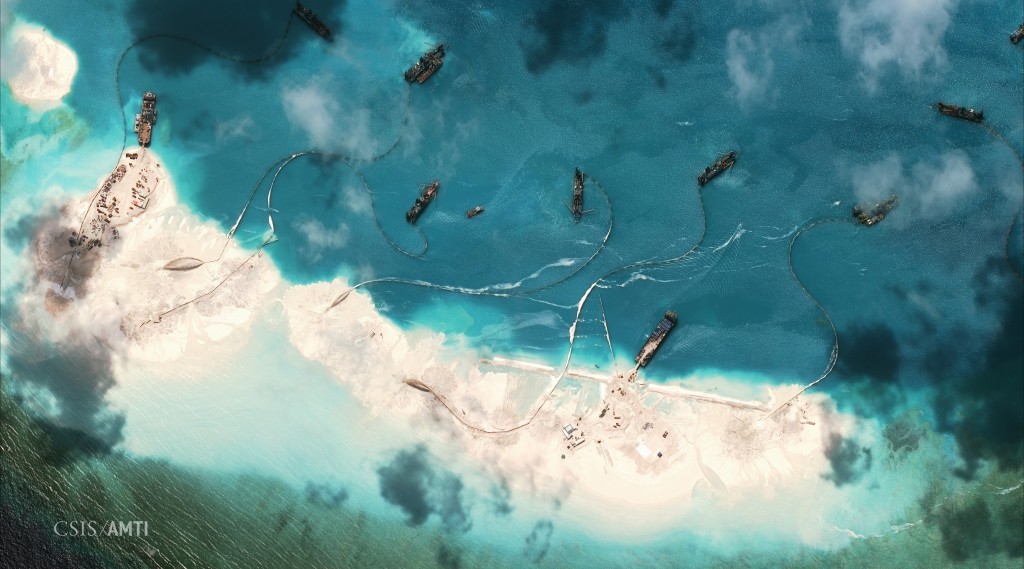PH outgunned in China’s island-building frenzy

THE reclamation activities of China in Panganiban (Mischief) Reef, an area within the Philippines’ exclusive economic zone in the disputed West Philippine Sea (South China Sea), has progressed in a few months, latest satellite images showed.
PAG-ASA ISLAND, West Philippine Sea—The Armed Forces of the Philippines chief of staff, Gen. Gregorio Pio Catapang Jr., looks worried as he surveys the rusted cranes and eroded runway on the tiny island of Pag-asa, now on the front line of a rapidly intensifying construction war in the South China Sea.
Fewer than 48 kilometers away, China’s giant construction cranes glint on the horizon, a sign of the Asian giant’s reef-building frenzy in the disputed Spratly chain that has seen new islands appear seemingly overnight.
As China and fellow rival claimant Vietnam race to pave over reefs and build structures in the strategically important sea, the Philippines stands out as a laggard.
The 356 residents of the remote Philippine-held coral outcrop of Pag-asa (international name: Thitu) fear they will soon be forced out by China’s aggressive land grab, in a conflict fought, so far, with dredgers and cement.
“Before we landed we saw the reclamation in the [nearby] Zamora Reef (Subi Reef) and it’s really enormous,” Catapang said on a tour of the island’s largely decrepit facilities.
Article continues after this advertisementAn old Philippine Navy transport ship, the BRP Sierra Madre, lay half-submerged in waters off the coast, on Ayungin Shoal (Second Thomas Shoal), with two antiaircraft guns the only visible defenses.
Article continues after this advertisementAggressive actions
China claims nearly all of the South China Sea, even waters approaching the coasts of its Asian neighbors, and in recent years it has caused alarm with increasingly aggressive actions to assert its claims and increase its presence.
The Spratlys, an archipelago of more than a hundred islands, reefs and atolls between Vietnam and the Philippines, is one of the most hotly contested areas because of its strategic military importance.
The United States last week sounded the alarm, accusing China of building up to 780 hectares of artificial islands in the Spratlys, and warning it could construct airfields, surveillance systems and harbors that would jeopardize regional stability.
Alarmed at the Chinese activity, other Spratlys claimants have not been idle. Vietnam is reported to be reclaiming land in two areas, while Taiwan and Malaysia have announced plans to improve their naval facilities.
The Philippines, which occupies nine islands or reefs in the chain, in contrast has done very little partly because of funding constraints, but also because it is pinning its hopes on having the United Nations mediate the dispute.
‘This is bad for us’
Life is usually uneventful for the inhabitants of Pag-asa, the largest Philippine-occupied island that lies 433 km from the major Philippine island of Palawan, and receives electricity just five hours a day.
They include soldiers, Philippine Coast Guard personnel and military-employed civilians, many of whom bring their wives and children with them to stave off loneliness.
But the Philippine Army says since last month, Chinese vessels off Zamora Reef have warned Philippine Air Force planes flying in and out of Pag-asa to leave, saying they are violating China’s military airspace.
“This is bad for us who live here. We depend on the planes to deliver our food,” said one concerned municipal employee, 37-year-old Larry Jugo.
Rear Adm. Alexander Lopez, commander of Philippine military’s Western Command, said the action was effectively an enforcement of an undeclared air defense identification zone.
“They build these things, they say for legal reasons, but for military purposes as necessary. That’s very alarming,” Lopez said.
Unmindful of world opinion
Elsewhere in the Spratlys, Lopez said China had also been harassing Filipino vessels supplying Marines on Ayungin Shoal. The puny unit of nine men lives on the rusting BRP Sierra Madre, which the Philippines grounded on the shoal in 1999 to mark its territory.
On Wednesday, Lopez said China was unmindful of world opinion and international law because of its size.
He dared China to bring Filipino and international journalists to the artificial islands it is building for transparency.
Lopez said China must show the world that it is not engaged in a massive land reclamation in disputed territories in the sea, either for economic or military purposes.
Lopez praised Catapang for bringing Chinese journalists to Pag-asa on Monday to show them that the Philippines was not reclaiming land in the Spratlys, contrary to their government’s claim.
He said the Chinese journalists did not raise the question of Philippine occupation since Presidential Decree No. 1596 declared Pag-asa part of the Philippines’ territory.
China has also been driving away Filipino fishermen at Panatag Shoal (Scarborough Shoal), 595 km to the northeast of the Spratlys and within the Philippines’ exclusive economic zone but which China siezed after a two-month maritime standoff in 2012.
Philippine authorities and regional analysts see it as a powerful campaign aimed at making it impossible for the Philippines to hold on to its claims.
“As far as I know, there is not much that the Philippines can do,” even if it wins its UN case, said Harry Sa, an American research analyst for the Singapore-based S. Rajaratnam School of International Studies.
“I think China is doing something smart: It is gaining territory without firing a single shot.”–Reports from AFP and Cynthia D. Balana